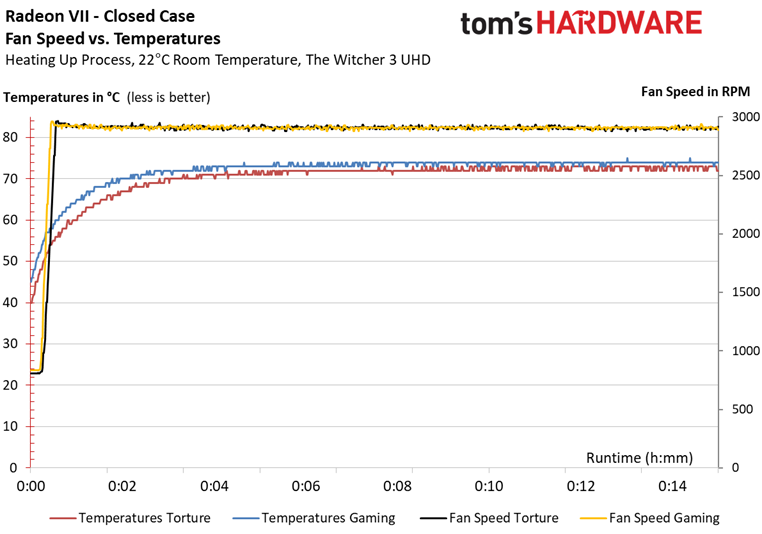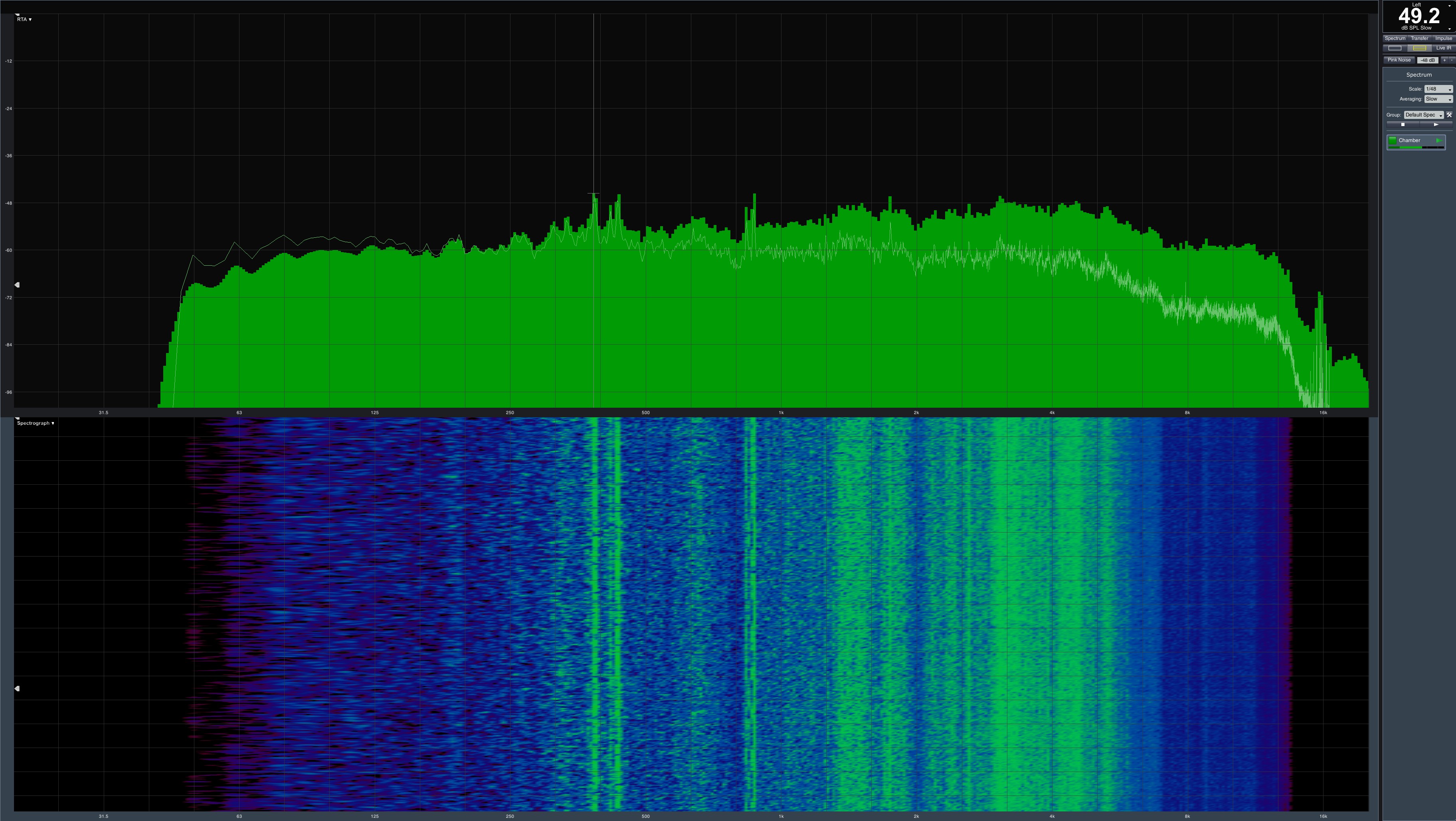AMD Radeon VII 16GB Review: A Surprise Attack on GeForce RTX 2080
AMD is first to market with a 7nm gaming GPU. The company complements its Vega 20 processor with 16GB of HBM2 on a 4,096-bit bus, packing it all into a 300W Radeon VII graphics card. Should those numbers impress you? Yeah, actually, they should.
Why you can trust Tom's Hardware
Fan Speed and Noise
AMD does not implement a semi-passive mode, which we're fine with. At idle, the three axial fans spin between 800 and 820 RPM, operating quietly. We did, however, measure some variation in their rotational speed using a laser tachometer, despite receiving the same PWM signal. At higher speeds, they give off a slight oscillating noise since their differences fall into an audible frequency.
That floating noise isn't the worst of Radeon VII's acoustic issues, though. A peek at the fan curve makes it clear how aggressive AMD is being with Vega 20's performance. In less than three seconds, the card goes from its idle fan speed straight up to its maximum. As you can imagine, this makes for a jarring experience compared to competing solutions that ramp up slowly in response to load. In both our U.S. and German labs, test notes indicate initial alarm that something was malfunctioning.
As mentioned on the first page, we approached AMD about our findings and were told that this behavior is intended. Although Radeon VII exhibits similar maximum-load acoustic performance as the reference Radeon RX Vega 64, that quick ramp from idle to 2,900 RPM explains why the new card seems so much louder. Again, the proposed solution is a manual adjustment in WattMan. Unfortunately, any attempt to relax Radeon VII's ability to cool itself off is going to cost you sustainable clock rates, negatively affecting performance.
AMD maintains that enthusiasts care more about their frame rates than noise, and we'd tend to agree. In this case, however, Nvidia's GeForce RTX 2080 Founders Edition card doesn't require the same sort of trade-off. Bear in mind that Nvidia's reference design does cost $100 more than Radeon VII. How do the two cards size up? Let's have a look at the measured values for both products, side by side.
| Header Cell - Column 0 | AMD Radeon VII | Nvidia GeForce RTX 2080 FE |
|---|---|---|
| Maximum Fan Speed, Open Test Bench | 2,927 RPM (Gaming workload) | 1,907 RPM (Gaming workload) |
| Average Fan Speed, Open Test Bench | 2,911 RPM (Warmed up) | 1,887 RPM (Warmed up) |
| Maximum Fan Speed, Closed Case | 2,949 RPM (Gaming workload) | 1,959 RPM (Gaming workload) |
| Average Fan Speed, Closed Case | 2,927 RPM (Warmed up) | 1,942 RPM (Warmed up) |
| Peak Noise Measurements (Gaming workload) | 49.2 dB(A), Closed case | 39.6 dB(A), Closed case |
| Idle Noise Measurements | 32.1 dB(A) | 31.3 dB(A) |
Spectrum Analysis
The 49.2 dB(A) result is based on the 2,947 RPM fan speed observed in a closed case. We applied our gaming load with Radeon VII on an open test bench in our measurement chamber and fixed the card's fans to 2,950 RPM, replicating the same conditions.
With GeForce RTX 2080 Founders Edition subjected to similar methodology, AMD's flagship ended up a full 10 dB(A) higher. What AMD asks of its cooler in order to match Nvidia's performance is not acceptable at the same price point.
Under load, Radeon VII is simply too loud. You can tune it for quieter operation if you want. But if you ran Nvidia's GeForce RTX 2080 at the same fan speeds that AMD is using, its TU104 GPU would achieve higher GPU Boost frequencies, improving its relative position. A more fair comparison would involve benchmarking both cards at the same noise levels. After all, Radeon VII is tuned for performance, ignoring power and noise, while GeForce RTX 2080 offers a better balance between all three variables.
Get Tom's Hardware's best news and in-depth reviews, straight to your inbox.
MORE: Best Graphics Cards
MORE: Desktop GPU Performance Hierarchy Table
MORE: All Graphics Content
Current page: Fan Speed and Noise
Prev Page Power Consumption Next Page Temperatures and Clock Rates-
cknobman I have to say (as an AMD fan) that I am a little disappointed with this card, especially given the price point.Reply -
velocityg4 This might be an attack on the RTX 2080 if the price was closer to that of an RTX 2070. Looking at the results in the article. It only approaches RTX 2080 performance in games which tend to favor AMD cards. Yet even in those it barely surpases the RTX 2080. While the RTX 2080 soundly beats it in nVidia optimized titles. I'd say it would be an RTX 2075 if such a thing existed.Reply
Don't get me wrong. It is still a better card than an RTX 2070. But it's performance doesn't justify RTX 2080 pricing. Based on current pricing on PCParticker of the 2070 and 2080. $600 USD would be a price better suited for it.
Compute is a different matter. Depending on your specific work requirements. You can get some great bang for your buck.
Still it would be nice if AMD could blow out the pricing in the GPU segment as it does in the CPU segment. Although their strategy may be more of an attack on the compute segment. Given the large amount of memory and FP64 performance.
21749331 said:Under the hood, AMD’s Vega 20 graphics processor looks a lot like the Vega 10 powering Radeon RX Vega 64. But a shift from 14nm manufacturing at GlobalFoundries to TSMC’s 7nm node makes it possible for AMD to operate Vega 20 at much higher clock rates than its processor.
Did you mean predecessor?
-
richardvday they cant lower the price without losing money on each card that memory cost so much its half of the BOMReply -
King_V Reply21749475 said:they cant lower the price without losing money on each card that memory cost so much its half of the BOM
I know this has been mentioned, but do we have any hard data where we know this for certain?
I remember asking someone before, and they posted a link, but even that seemed to be a he-said-she-said kind of thing.
I do have to agree, though, overall, with a vague disappointment. Given its performance, value-wise, it seems this is worthwhile only if you really want at least two of the games in the bundle.
I hadn't thought about what AMD's motivation was, but the thought that even AMD was caught a little by surprise at Nvidia's somewhat arrogant pricing for the RTX 2070/2080/2080Ti, and "smelled blood" as it were, is somewhat plausible. -
redgarl Something is wrong with your Tomb Raider bench, techspot results are giving the RVII the victory.Reply -
timtiminhouston I am an AMD fan but AMD needs to stop letting sales gurus dictate everything. The fact is AMD is WAY behind Nvidia at this point, and there is absolutely no way they should have disabled anything from the datacenter card to make up for not having Tensor OR Ray Tracing; they should have only had less memory. I understand reviewers trying not to savage the card, but let's be honest, if I won this card I would probably sell it unopened. I am all about GPGPU, and in the HD7970 at least I had massive compute compared to the competition (125k Pyrit hashes/sec), even though Nvidia was still better in most games. Not only is this card not better in gaming, it is way behind in GPGPU technology. I look forward to buying a used RTX card in a year or two to see what else the Tensor cores can be used for on Linux, but not so much this card. If I saw it for $300 on Craigslist I might be tempted, but GPU and memory prices are still way over inflated due to the cryptoscam boom. Luckily it looks like they are running short of suckers. This is a hard pass, and no way I can recommend it. A used GTX 1070 or Vega 56 for 200 is far better bang for buck. Hold your money for a year or so.Reply -
edjetorsy I am not impressed by this AMD graphical card at almost the same price for a RTX2080 more performance and lower power consumption.Reply
The Ryzen CPU however I am interested in, the 2700X is a good deal and waiting for the Ryzen 3e generation to appear and see what this baby can do compare to Intel high end . But no I own a GTX1070 il think I pass this whole RTX and Radeon VII generation, there is not so much to gain for the price at this time. -
shapoor12 can't understand the 331mm2 die size on readon vii while rtx 2080 have 545mm2 , amd could smash Nvidia by making bigger cards. why u doing this to yourself AMD? WHY?WHY?Reply -
Olle P At least it's the first 7nm consumer-marketed GPU to the market.Reply
The price cut from ~$5,000 (vanilla MI50) to $700 doesn't hurt.
Some undervolting and -clocking should do wonders to noise and heat.
Time to sit back and wait for Navi... -
Fulgurant "Nvidia’s Turing-based cards proved this by serving up solid performance, but simultaneously turning many gamers off with steep prices. It was only when the company worked its way down to GeForce RTX 2060 and had to compete against Radeon RX Vega 56/64 that it got serious about telling a more compelling value story."Reply
I don't see how the 2060 is a compelling value story. Sure, it's more cost-efficient than its high-end cousins, but the 2060 offers very little in the way of a performance increase to people who were in the same price bracket previously (1070 owners), and it offers an enormous price and power premium to people who own 1060s.
Spent ~$370 almost 3 years ago for an Nvidia card? Well now you can plop down roughly the same money for about a 15% performance increase and a 2 GB loss of VRAM. That tech-journalists actually tout this as great progress mystifies me.
Unfortunately this newest release from AMD doesn't look like it presages significant price pressure to bring Nvidia back down to earth. Things might get better as AMD drives towards down towards the midrange segment, but who knows? Here's hoping.


